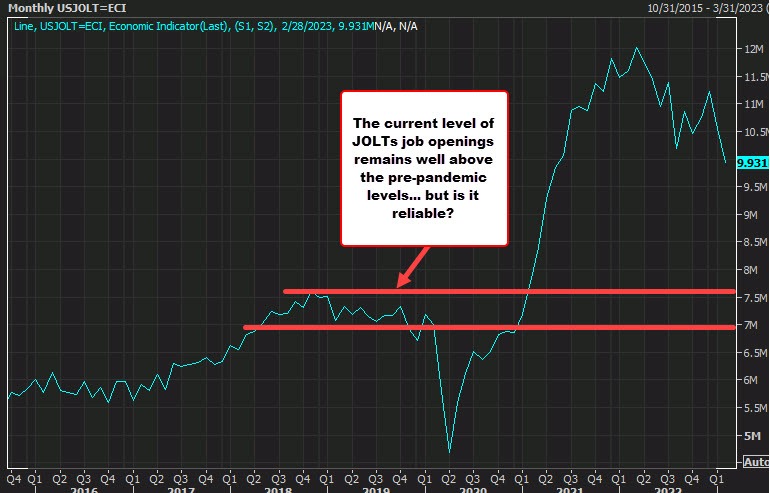
- Prior month 10.824M (est. 10.5M) revised to 10.563M
- Job Openings for February 2023 moves to 9.931M vs 10.4M estimate and 10.563M last month
- Quits rate 2.6% vs 2.5% last month. Total quits came in at 4.024 million versus 3.878 million was more than
- Hires 4.0% vs 4.1% last month. Total hires came in at 6.163 million versus 6.327 million last month
- Separations 3.7% of versus 3.8% last month. Total separations came in at 5.82 million versus 5.90 million last month
Overall the quits rate increase which is thought to be a positive as workers don't quit unless I have another job, but the job openings did fall. Hires was lower as was a separations. Overall looking at the chart above, the job opening remains well above the levels pre-pandemic (around 7M to 7.5M).
However, how good is the data?
The JOLTS report is a monthly publication by the U.S. Bureau of Labor Statistics (BLS) that provides detailed data on job openings, hires, and separations in the United States. It is older data. The current report is for February. Nevertheless, it offers valuable insights into the labor market, and economists and policymakers use this information to assess the overall health of the economy. The main components of the JOLTS data include:
- Job Openings: The number of job vacancies available on the last business day of the month, reflecting the demand for labor.
- Hires: The total number of people hired during the month, indicating the strength of the labor market and job creation.
- Separations: The total number of employment terminations during the month, which can be further broken down into quits, layoffs and discharges, and other separations.
There has been some concerns of late that the data is not reliable. Adam wrote in a prior post:
"The problem is that large companies no longer follow the old-fashioned protocol of:
- Realize you need a worker
- Advertise a job
- Fill it
Instead, they're 'always hiring' and leaving up job postings when they're not hiring. In turn, job-seekers have resorted to spamming companies and job sites.
It's even worse than I thought. Today the WSJ writes about how more than half of companies who post job advertisements they weren't actively trying to fill did so "to give the impression the company was growing." Another large portion did so to trick overworked employees into the belief that help would be coming soon. Further reasons include stockpiling a pool of ready applicants if an employee quits or to be ready of an irresistible candidate applies.
They're now being called 'ghost jobs' and they may have been part of what convinced the Fed that the economy was overly strong."
So be careful
/inflation



